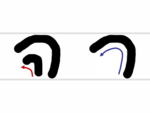Hebrew/Aleph-Bet/2
| Lessons on the Hebrew Aleph-Bet |
|---|
| Introduction |
| 1 א בּ ת • E |
| 2 ב ה נן • E |
| 3 מם שׁשׂ • E |
| 4 ל ו • E |
| 5 ד ר י • E |
| 6 ג ז ח • E |
| 7 ט ככּך • E |
| 8 ס ק • E |
| 9 ע פפּף • E |
| 10 צץ • E |
| Review |
| Test • Answers |
| edit template • talk |
Welcome to the second lesson of the Hebrew alphabet! In this lesson you will learn three new Hebrew letters - ב ה and נן, two new niqqud symbols - qamats and tsere, as well as the definite article in Hebrew.
Letters
[edit | edit source]So far we have learned 3 letters: א, בּ and תּ. Now we will learn two new letters:
Vet
[edit | edit source]ב Remember the previous lesson we learned that the dot in the Bet is important? Well, here is why. When Bet loses the dot it becomes Vet and stands for the "v" sound (IPA: /v/, "v" as in "violin"). Note that normally it isn't considered a separate letter from Bet.
He
[edit | edit source]
ה The fifth letter in the Hebrew alphabet is He. It makes the "h" sound (IPA: /h/, "h" as in "heart"). When at the end of a word it is silent.
Nun
[edit | edit source]נ ן The fourteenth letter in the Hebrew alphabet is Nun. It makes the "n" sound (IPA: /n/, "n" as in "name"). When at the end of a word, it changes form. This final form is known as Nun Sofit - ן ("Sofit" is Hebrew for "final"). A few letters in the Hebrew have this property, and Nun is one of them.
Vowels
[edit | edit source]The following vowels resemble in pronunciation Pataħ and Shva, but they are different depending on the accent. Many Israelis pronounce them (Pataħ and Qamats, Shva and Tsere) the same.
Qamats
[edit | edit source]בָּ The qamats is the horizontal line with the smaller vertical line under the Bet.
Like pataħ, qamats produces the "a" sound (IPA: /a/, "a" as in "spa").
Tsere
[edit | edit source]בֵּ
The tsere is the two horizontal dots under the Bet.
Tsere produces the "e" sound (IPA: /e/, "e" as in "bet").
Definite He - He Hayedi‘ah
[edit | edit source]In English there are two different types of articles: definite ("the") and indefinite ("a"/"an"). In Hebrew, while there is a separation between the definite and indefinite, there exists an article only for the definite; that is, there is no "a" or "an" in Hebrew, just "the". If the noun or adjective doesn't have the definite article, it simply means it is indefinite.
Unlike English, where the definite/indefinite article exists as free form (a separate word), in Hebrew the definite article appears as an affix. By simply adding the letter He ה to the beginning of any noun or adjective, regardless of its gender and number, the word becomes definite. The definite He is known as He Hayedi‘ah (lit. "knowledge He").
Why don't we implement it on the noun we know?
בַּת bat (singular, feminine, indefinite) "daughter"
We add the letter ה and the result:
הַבַּת habat (singular, feminine, definite) "the daughter"
Words
[edit | edit source]In Hebrew there are two genders: masculine and feminine. Learning the gender of every word is important, because in Hebrew, almost everything has a gender, even numbers. Finding a gender just by looking at a word is harder than the Romance languages, especially Spanish, but somewhat easier than say German. In most cases, words ending with Tav or He are feminine. There are numerous exceptions.
With two new letters and two new niqqud signs we can put together even more words! First let's look at the vocabulary we have so far:
אַתְּ at you (singular, feminine)
בַּת bat daughter, girl (singular, feminine)
Now we'll add some more words. We have the singular feminine form of "you". What about the masculine form?
אַתָּה atah you (singular, masculine)[1]
And we have a "girl", what about a boy?
בֵּן ben son, boy (masculine, singular)
Other new words:
תָּא ta cell, cab (truck), cabin, locker, cubicle, group (people) (masculine, singular)
אָב av father (masculine, singular)
אַבָּא aba dad (masculine, singular, informal)
בָּנָנָה banana banana (feminine, singular)[2]
Summary
[edit | edit source]In the past 2 lessons, you have learned:
- The Hebrew letters and forms Aleph א, Bet בּ, Vet ב, He ה, Nun נ, Nun Sofit ן and Tav ת.
- The niqqud symbols Qamats (ָ), Pataħ (ַ), Tsere (ֵ) and Shva (ְ).
- The words אַתְּ, אַתָּה, בַּת, בֵּן, תָּא, אָב, אַבָּא and בָּנָנָה.
- The definite article in Hebrew - He Hayedi‘ah.
Practice what you've learned in the exercises.
